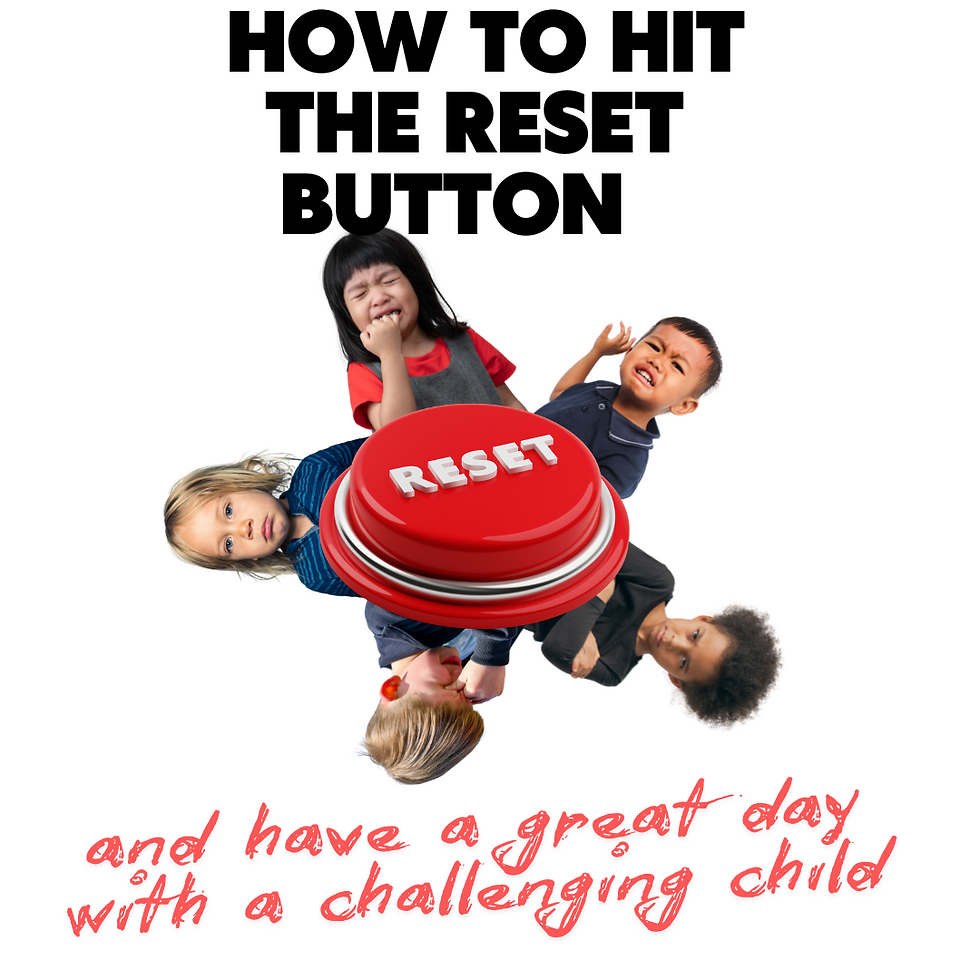How To Hit The Reset Button And Have A Great Day With A Challenging Child
- Nanci Bradley
- Feb 18
- 4 min read
Updated: Apr 5

Sometimes you really need to have a good day.

Some children are born more challenging than others. After 5 decades of providing child care, I know this for sure. When you're caring for a challenging child or challenging children, you may feel beaten down at times.
The 2-step technique I'm about to show you works. It doesn't matter if you have decades of experience like me or you're just learning about young children's behavior, it's works regardless. It works even when you think you don't need it. It works with challenging and not so challenging children as well.
Note: It would be easy for any seasoned provider or parent to gloss over this and think about it in your head instead of actually doing the steps. Please don't skip a step. Actually write this down and plan those activities. It only takes a minute and it could save you many more.
The best time to get started is after bedtime in order to get a great start on your day first thing in the morning.

Step 1
Get a pen (or marker) and paper and make a list in large letters of your child's 10 best traits and qualities. Do this for each of your children. Hang it where you'll see it often.
From the time you greet the child in the morning, start to look for those traits and call them out. Let them know how those traits are helpful to you. Also, remember to call out the good traits of others in the group or family.

You picked up my pen. That was helpful Stuart.
I love to see your smile in the morning, Octavia. It helps me feel happier.
I noticed that you brought your plate to the counter after lunch and nothing spilled. Thanks, Mary. That was helpful.
Raj put the lid back on the playdough. That way it will stay soft. That's so helpful, Raj.
Thanks, Howie, for bringing Penny her jacket. That was helpful!
"I noticed you finished your b-fast with plenty of time today, Sheldon. That was helpful to everyone!"
Be specific
Use their names
Let them know how it was helpful to you or the group.
Step 2
Plan some sensory activities during your day. The best, most engaging activities involve many different senses. Here's a list of ideas. I'm sure you can think of many more.
Sand Play, Water Play, Sand and Water Play, Swinging, Paint with Water Colors, Play with Sponges and Water (tip: put containers 1/2 filled with water on top of towels for less mess), Plant Seeds, Clay, Watering Plants, Smelling Spices, Spray Bottle with Water Outside, Playgrounds, Play Dough!

The more play dough the better. Here's a great recipe if you want to make your own:
In a medium saucepan or electric skillet combine:
2 Cups Water
2 Cups Flour
1 Cup Salt
4 Tbsp. Vegetable Oil
4 Tsp. Cream of Tartar
Food Color (optional)
Stir constantly over medium heat until the dough pulls from the sides of the pan and is the consistency of very thick mashed potatoes. Turn it out onto a table and start playing with it as soon as it cools a bit. Store in an airtight container.
When they play with the dough, supervise them as much as you need to so they don't make a big mess. That prevents you from getting nervous or upset. Remember to notice when they're helpful and call it out immediately. Always give a 5-minute warning when an activity needs to end to avoid meltdowns.
The combination of noticing their best efforts and providing an engaging, soothing learning environment is guaranteed to improve their behavior by at least 50%, making an easier, less stressful day for you. Try it and let me know how it works!

Do you need the right words to use in frustrating situations with young children? Like cleaning up, tattling, hitting or just plain not listening?
If you want to see the exact words that child care professionals use to get kids to listen without yelling or time-outs, we have a great new resource for you. In this guide is the secret to staying positive while retaining respect. These are the exact words excellent child care teachers use to maintain good-natured control in their classrooms. Why shouldn't everyone have these secrets?
Teachers who stick with the profession long enough learn to take good care of themselves so that they can continue to take good care of others. That's the reason for the self-care box! Open it up and enjoy. (no email needed.) You deserve it.
Nanci J Bradley is a child and family educator, parent, author, family aerobics instructor, and all-around fun-loving person. She believes in the power of sleep, lifelong learning, healthy eating, fun, and more than anything else, PLAY! She studied early childhood education at Triton College and received her BS in education from Northern Illinois University in 1986. She received her MA in human development from Pacific Oaks College in 2011. She lives and teaches in Madison, WI

Comentarios